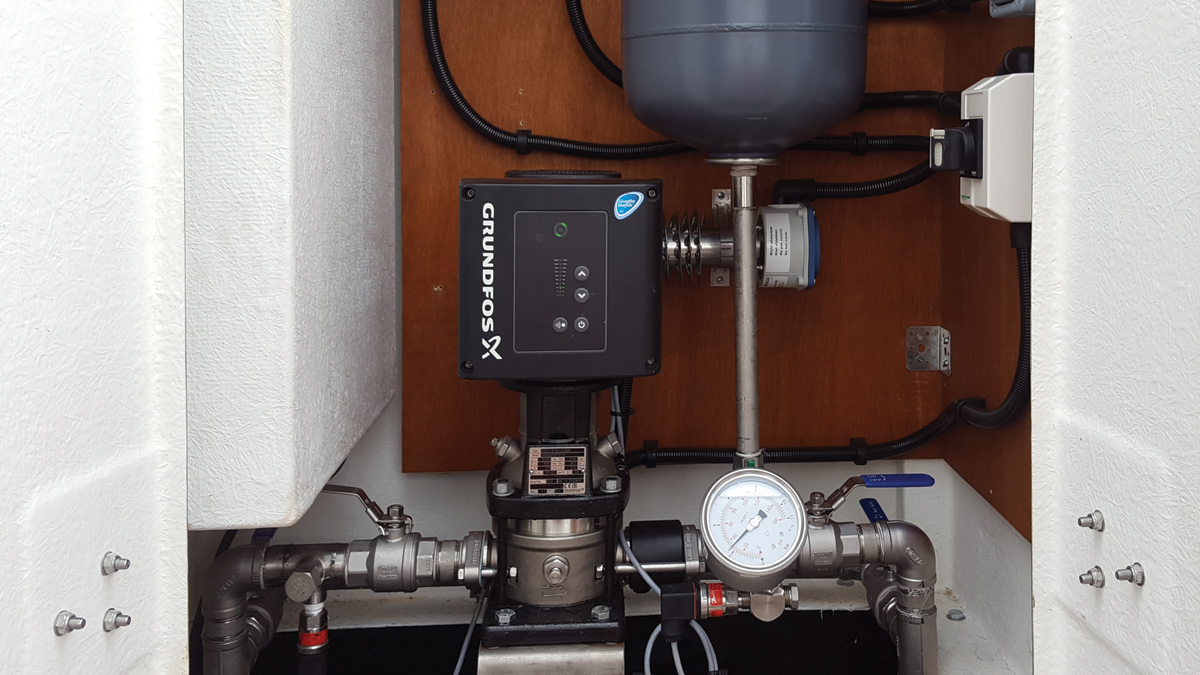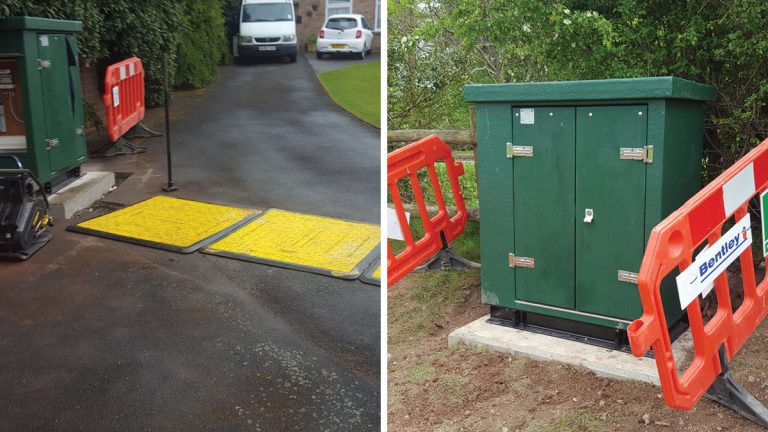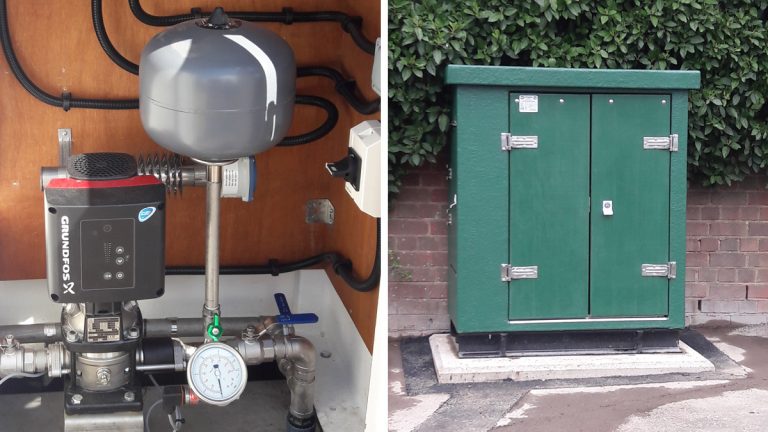Severn Trent DG2 Small Pumps Project (2017)

Grundfos pumpset - Courtesy of JN Bentley
DG2 (Director General 2) is a status where, according to Ofwat, a customer receives inadequate water pressure generally under 1bar at their point of connection to the water main. Water companies are subject to annual regulatory fines for properties on the DG2 register above a threshold. Severn Trent Water arranges its distribution to cater for as many customers as possible, providing at least 2bar pressure at the highest point in the DMA, stripping out the outliers. This results in a pressure of 1.5bar at the point of connection and works for 99% of customers, but some elevations are too high to set the network against without causing big leakage problems; particularly in older (over 100 years) parts of the network. There is a fine balance between low pressure and leakage when it comes to distribution; if the pressure is too high leakage increases, if the pressure is too low then customers at high elevations suffer. In the absence of operational solutions on the water network such as DMA rezoning, Seven Trent defaults to capital schemes (installing pumps and/or pipes). Unfortunately some properties remain on the register for long periods due to high cost to resolve.
Introduction
Though the DG2 small pumps project covers the whole of the Severn Trent Water region, this case study focuses on a specific installation currently ongoing in Stourbridge. The project in its entirety involves installing 23 (No.) new booster pumps to increase water pressure to 31 (No.) properties.
A conventional booster pump includes hard wired telemetry and an outstation to send signals to the control center via a phone line. Alarms are visible at a remote location where controllers would monitor and despatch resources accordingly. It also includes a control panel for the pumpset.
It was determined in AMP4 that a conventional booster pump costing £90,000 to address single property pressure was not cost beneficial to the business. This left Severn Trent with a long-standing problem for many years. A working group was created and revisited the delivery strategy to pumped solutions. In late 2015 a brief was issued to two pump suppliers to design a pumpset that fits Severn Trent’s needs at the lowest cost possible.
The pump companies were given access to pressure data, flow ranges and site elevations. Grundfos Pumps won the contract and their standard product included an assembly inside a GRP kiosk, ready to be piped up to the network and fixed to a concrete plinth. The kiosk is supplied by Morgan Marine.
The Grundfos pumpset
Grundfos’ pump design was innovative in that it did not have a control panel telling the pump what to do; it simply worked off pressure transducers and a pressure vessel. The pump was designed to combat cavitation and low flows. At 65db inside the kiosk, noise was not a factor. In addition to a different type of pump control, Severn Trent also managed to remove the outstation element on pumps supplying up to a maximum of 8 properties.
The agreed alternative was the installation of a pressure logger on a tap-in point on the discharge pipework inside the kiosk. Pressure loggers have batteries and send pressure data to the control center via GPS. These two main changes have resulted in massive savings and made the project feasible from a cost perspective. The standard product shown below is costed at £6,800.

Pumpset during construction (Stourbridge) – Courtesy of JN Bentley
Delivery phase and partners
Once the pump design was finalised a contractor was sought to take 31 properties off the register. Design and build contractor Mott Macdonald Bentley (MMB) won a mini tender competition. Their target price was a competitive £430k, which was at least 30% less than the AMP5 equivalent. Scottish Power and Western Power Distribution were the two district network operators. Fisher German was selected as the land and planning agent to deal with noticing, private land etc.
The installation of the pumpset is straightforward and involves little excavation at the site. It comes as an electrically safe asset with NICEIC certification. The pumpsets are fixed onto a 150mm deep plinth, plumbed into the pipework, powered up, commissioned, chlorinated, and put into supply.
The pumpset generally goes onto a service main or on the end of the DMA as this ensures no disruption to other customers. Severn Trent’s methodology to satisfy the regulator is to provide evidence of good pressure readings for at least for 10 consecutive days without issues. Once it is proved that (at least) the minimum pressure is being supplied, the property is removed off the DG2 register.
First site: Dewsbury Close in Stourbridge
One particular customer lives only 2m higher than his neighbour who receives adequate water pressure. Severn Trent discussed the matter and it was agreed to site a pumpset adjacent to a wall to the front of his property. The pump was subsequently installed on his service main meaning that the installation had no impact on others in the DMA. A temporary pressure logger was installed in his garden tap to gather the data.
It took a couple of efforts to deliver the right pressure because there were massive headlosses on the service main, but eventually the feedback from the customer was categorical; he was delighted to receive good water pressure for the first time in over 24 years.
The pump
The effect on the Operations team in Severn Trent will be negligible. Whilst new assets are being added to the database, the energy costs are small and new maintenance is light. The pump is designed to be replaced if it fails (pump unit price is £500). This is a major deviation from the standard for non-infrastructure assets.
Without a control panel the operations team simply needs to isolate power supply in the metering cabinet to swap out the pump. Most non-infrastructure assets are complex and require authorisations to work on, but these are simplistic. It is hoped that power provision is the next area where Severn Trent will strive for improvements.
Renewable energy might be possible as the power demand on a 0.55kW pumpset is small (less than a TV). The kiosk includes a light on the inner wall. It includes a thermostatically controlled bar heater to combat temperature to about -20 degrees.

(left) Pumpset and (right) kiosk on plinth (Stourbridge) – Courtesy of JN Bentley
Conclusion
Evidence to date shows that the pumpsets are working as intended and it will become business as usual for resolving deferred properties. The anticipated completion date of the programme is the end of September 2017.




